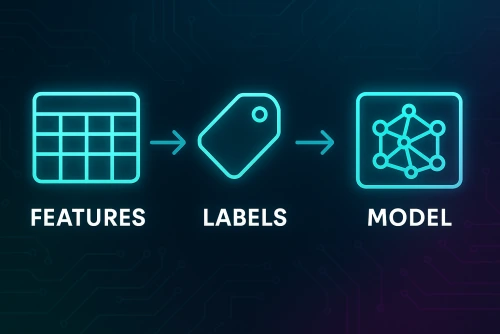As we journey deeper into the world of Machine Learning (ML), you'll frequently encounter terms like "features," "labels," and "models." These are the fundamental building blocks of most ML systems. Understanding them clearly is crucial for grasping how machines learn.
Let's break them down with simple examples.
What are Features?
Features are the individual measurable properties or characteristics of the phenomenon being observed. Think of them as the input variables that your ML algorithm uses to make predictions or find patterns.
Simple Analogy: If you're trying to predict if it will rain, your features might be:
- Current temperature (e.g., 25°C)
- Humidity level (e.g., 70%)
- Cloud cover (e.g., "cloudy," "partly cloudy," "clear")
- Wind speed (e.g., 15 km/h)
Another Example (Spam Email Detection):
- Does the email contain the word "free"? (Yes/No or a count)
- Does the email contain misspelled words? (Yes/No or a count)
- What is the length of the email subject?
- Is the sender in your contact list? (Yes/No)
House Price Prediction Example:
- Square footage of the house.
- Number of bedrooms.
- Number of bathrooms.
- Age of the house.
- Location (which can be broken down into more specific features like zip code, proximity to schools, etc.).
In a dataset, features are often represented as columns, where each row is an individual observation or data point.
Feature Engineering: Sometimes, the raw data isn't in the best format for an ML model. Feature engineering is the process of selecting, transforming, or creating new features from the existing data to improve model performance. For example, instead of using a customer's birth date, you might engineer a feature for their "age."
What are Labels?
A label is the output variable we are trying to predict. It's the answer or the outcome that corresponds to a set of features. Labels are primarily used in Supervised Learning (where the machine learns from labeled examples).
Simple Analogy (Rain Prediction):
- The label would be: Will it rain tomorrow? (Yes/No)
Spam Email Detection Example:
- The label for each email would be: Is it "spam" or "not spam"?
House Price Prediction Example:
- The label for each house would be: Its actual selling price (e.g., $350,000).
In a supervised learning dataset, the label is typically the special column you are trying to teach your model to predict.
Unsupervised Learning: In Unsupervised Learning, you generally don't have predefined labels. The goal is to discover patterns or structures (like clusters) within the features themselves.
What is a Model?
A model, in the context of Machine Learning, is a mathematical representation of a real-world process that is learned from data. It's the output of the training process – the "thing" that has learned the relationship between features and (in supervised learning) labels.
Think of it as a set of rules, a mathematical equation, or a complex structure (like a decision tree or a neural network) that takes new input features and produces an output (a prediction).
Simple Analogy (Rain Prediction):
- After training on historical weather data (features) and whether it rained or not (labels), the model might learn a rule like: "If humidity is above 80% AND cloud cover is 'cloudy', then there's a high probability of rain."
How Models are Created:
- You choose a type of model (e.g., Linear Regression, Decision Tree, Neural Network). An overview of common algorithms can be found here.
- You train this model by feeding it your data (features and labels).
- During training, an algorithm adjusts the internal parameters of the model to best map the input features to the output labels (in supervised learning) or to find patterns (in unsupervised learning). This process can sometimes lead to overfitting or underfitting.
Once trained, the model can be used to make predictions on new, unseen data. The performance of these predictions is then evaluated using various metrics.
Examples of Model Types:
- Linear Regression Model: Tries to find a linear relationship between features and a continuous label (e.g., predicting house price based on square footage).
- Decision Tree Model: Learns a set of if-then-else rules to make predictions (e.g., classifying an email as spam or not spam based on a series of questions).
- Neural Network Model: Inspired by the human brain, these are complex models capable of learning very intricate patterns, often used for image recognition or natural language processing. Deep Learning utilizes these extensively.
Putting It All Together
Let's revisit our house price prediction example:
- Features: Square footage, number of bedrooms, location, age of the house, etc.
- Label: The actual selling price of the house.
- Data: You collect data for many houses, each with its features and corresponding selling price (label).
- Model Training: You choose a model type (e.g., Linear Regression) and train it on this data. The model learns how different features influence the price.
- Prediction: Now, if you have a new house with its features (but no price yet), you can feed these features into your trained model, and it will predict the likely selling price.
Understanding features, labels, and models is the first step towards demystifying Machine Learning. These concepts form the bedrock upon which more complex ideas and algorithms are built. As you continue to learn, you'll see these terms appear again and again! For a broader picture, consider reading about the Data Science lifecycle.
Do you have a good analogy for features, labels, or models? Share it in the comments!

Comments